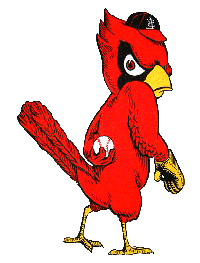
| Illuminations Home |
|
| St.
Louis Cardinals |
|
| Von der Ahe Years |
|
| Gashouse Baseball |
|
| St. Louis Swifties |
|
| Beginning
of the Busch Era |
|
| Gibby
& El Birdos |
|
| Whiteyball |
|
| Enter
the "Genius" |
|
| Baseball Heaven |
|
| Visiting Busch Stadium |
|
| Do the Cubs Really Suck? |
|
Illuminations, Epiphanies, & Reflections
Beginning of the Busch Era
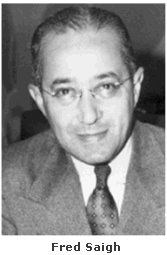 In 1953, Fred Saigh, the tax attorney owner of the
Cardinals, found himself in hot water with Uncle Sam over tax
improprieties of his own. He was convicted of owing over $19,000 in
back taxes, sentenced to fifteen months in prison, and forced to sell
his team. While the Cardinals were far more popular than the
Browns, Saigh's misfortune, coupled with the fact that the Cardinals
still leased space at the Brown's Sportsman's Park, made their sale to
an out-of-town owner seem likely. This was especially true as
interests in both Milwaukee and Houston were aggressively seeking teams
for their markets and offered Saigh $4.5 million dollars.
Instead, Saigh decided to sell the Redbirds to August Busch Jr. for
almost a million dollars less. When asked why, Saigh simply
stated, "I didn't want the Cardinals to leave St. Louis." There
is no reason to feel sorry for Mr. Saigh though; he recognized that
Anheuser-Busch was a
company on the rise and used his earnings to purchase shares of its
stock. By the time Mr. Saigh died in In 1953, Fred Saigh, the tax attorney owner of the
Cardinals, found himself in hot water with Uncle Sam over tax
improprieties of his own. He was convicted of owing over $19,000 in
back taxes, sentenced to fifteen months in prison, and forced to sell
his team. While the Cardinals were far more popular than the
Browns, Saigh's misfortune, coupled with the fact that the Cardinals
still leased space at the Brown's Sportsman's Park, made their sale to
an out-of-town owner seem likely. This was especially true as
interests in both Milwaukee and Houston were aggressively seeking teams
for their markets and offered Saigh $4.5 million dollars.
Instead, Saigh decided to sell the Redbirds to August Busch Jr. for
almost a million dollars less. When asked why, Saigh simply
stated, "I didn't want the Cardinals to leave St. Louis." There
is no reason to feel sorry for Mr. Saigh though; he recognized that
Anheuser-Busch was a
company on the rise and used his earnings to purchase shares of its
stock. By the time Mr. Saigh died in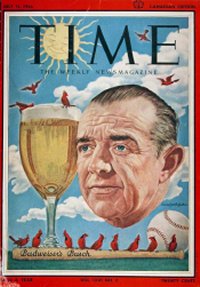 1999, his Anheuser-Busch portfolio was valued at almost $70
million. 1999, his Anheuser-Busch portfolio was valued at almost $70
million.With the sale of the Cardinals to Gussie Busch, the Browns' owner, Bill Veeck, realized he would no longer be able to compete in St. Louis and quickly moved the team to Baltimore where it was renamed the Orioles, selling Sportsman's Park to the Cardinals as he departed. Gussie Busch immediately attempted to change the name of the field to Budweiser Stadium in order to market his best selling beer but was forbidden to do so by Baseball Commissioner, Ford Frick. So instead, he proposed naming the field, Busch Stadium, apparently in honor of himself. Frick approved the proposal, and signs went up at the park proclaiming the new name. Within the year, Anheuser-Busch released a new regional beer, Busch-Bavarian--which was of course simply referred to as Busch, and tied its advertising campaign not just to skiing, bobsledding and "the mountains" but to the Cardinals and Busch Stadium as well. The rest is history as Gussie's products became indivisibly linked to the Cardinals, and Anheuser-Busch, which had been a distant third in beer sales behind Miller and Schlitz, overtook both to become the number one brewery with the best-selling beer, Budweiser, in the United States. The Cardinal radio announcers played a major role in Anheuser-Busch's 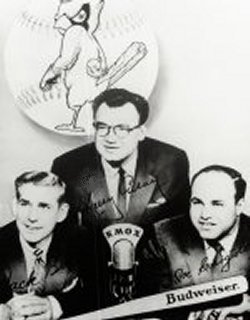 rising dominance. One
of the smartest things Gussie Busch did upon buying the Cardinals was--despite his personal
misgivings--agree to retain Harry Caray to do play-by-play for the
Cardinals. Caray had been doing Cardinal broadcasts with former
Cardinal manager, Gabby Street, and former Cardinal catcher, Joe
Garagiola, on WIL--a competitor of KMOX--and serving as the primary
spokesman for Griesedieck Beer--Budweiser's biggest local
competitor. When Busch suggested that Caray wouldn't make the
transition, the Cardinals were bombarded with letters from fans and,
more importantly, regional beer distributors, pleading him to change
his
mind. He did, and Caray--in partnership with Joe Garagiola and Jack Buck--became the lead voice of
the Cardinals and the most
influential Anheuser-Busch pitchman. rising dominance. One
of the smartest things Gussie Busch did upon buying the Cardinals was--despite his personal
misgivings--agree to retain Harry Caray to do play-by-play for the
Cardinals. Caray had been doing Cardinal broadcasts with former
Cardinal manager, Gabby Street, and former Cardinal catcher, Joe
Garagiola, on WIL--a competitor of KMOX--and serving as the primary
spokesman for Griesedieck Beer--Budweiser's biggest local
competitor. When Busch suggested that Caray wouldn't make the
transition, the Cardinals were bombarded with letters from fans and,
more importantly, regional beer distributors, pleading him to change
his
mind. He did, and Caray--in partnership with Joe Garagiola and Jack Buck--became the lead voice of
the Cardinals and the most
influential Anheuser-Busch pitchman. Gussie also spent some money on sprucing up the 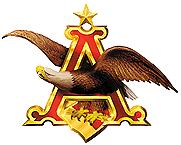 ball park, and one of
the most famous additions to his stadium was an enormous, colorful Anheuser-Busch logo mounted atop a Budweiser
sign that sat above the left-field scoreboard. Each
time a Cardinal hit a home run, the eagle would majestically flap its
wings as a smaller neon Cardinal would swing its bat and then fly
in
large figure-eights around the line scores. A
similar animated sign (filmed by Joseph A. Hess in 1962) without the
circling Cardinal was installed on U.S. Highway 40 near at the Market
Street exit where it flies to this day. ball park, and one of
the most famous additions to his stadium was an enormous, colorful Anheuser-Busch logo mounted atop a Budweiser
sign that sat above the left-field scoreboard. Each
time a Cardinal hit a home run, the eagle would majestically flap its
wings as a smaller neon Cardinal would swing its bat and then fly
in
large figure-eights around the line scores. A
similar animated sign (filmed by Joseph A. Hess in 1962) without the
circling Cardinal was installed on U.S. Highway 40 near at the Market
Street exit where it flies to this day. 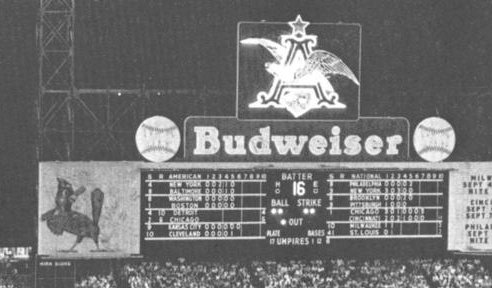 One of the often forgotten features of the old ballpark was its covered right field pavilion. I'm not sure if the pavilion was originally intended to be used for segregated seating, but that's how it was employed from the end of World War I until the mid-1940s when blacks were first allowed to purchase tickets for any seat in the house. However, in many respects St. Louis was a Southern city, and even after the restrictions were officially removed, many black families chose to remain in the pavilion, and I still remember my grandfather's response when in the early 1960s I asked if it would be 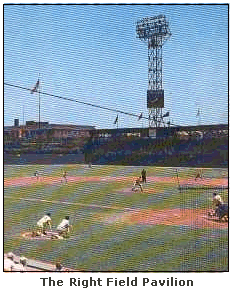 okay if we could sit in the shaded pavilion just
once. "No, son," he explained, "it wouldn't be right. That's where the colored
gentlemen get to watch the
game." okay if we could sit in the shaded pavilion just
once. "No, son," he explained, "it wouldn't be right. That's where the colored
gentlemen get to watch the
game." The most interesting thing about the pavilion was that while it sat above an 11 foot outfield fence, it had been entirely fronted with a 22 foot screen since 1929 when the Detroit Tigers hit eight home-runs into it during a four-game series against the Browns. The distance down the right field line was only 310 feet, which made little difference during the deadball era, but couldn't contain left-handed line drive hitters once the ball was juiced up. During the first year of Busch's ownership, the team counted the number of balls hit off the screen by Cardinals and their opponents to see if it was a benefit or hindrance. During the year, opponents knocked 18 line drives against it and the Cardinals, 35. The next year the screen was removed and homerun production for the Cardinals improved. Yet by 1956 for some unknown reason, the screen was back in place, and once again, the only way to hit a home run to right field was with a sky-high blast over the 33 foot barrier some 310+ feet away from home plate. While the Cardinals may have been great for the beer business, the team itself fell on some hard times during the 1950s. Stan Musial was the lone, consistent bright spot. Musial had never sought the limelight even in the Cardinals glory days of the 1940s. In fact, he seemed to avoid controversy, especially when the national--mostly New York--sporting 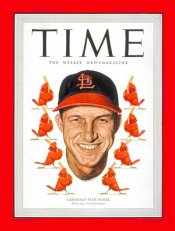 press began a campaign in 1945 to discredit his
batting accomplishments between 1942-1944. He only hit as well as
he did, it was claimed, because he faced inferior pitching as major
league staffs had been depleted by the World War. Musial, had
joined the Navy following the 1944 season and missed all of 1945.
Sportswriters cheerfully proclaimed that he would be a bust in the 1946
season when he had to face "real" pitchers. Yeah, right. In
1946, Musial led the lead with a .365 batting average, a .587 slugging
percentage, 228 hits, 50 doubles, and 20 triples. He was named
the National League Most Valuable Player. 1946 was also the year
that he received his nickname, "Stan the Man" when a Brookly Dodger fan was overheard whining as Musial
walked to the plate at Ebbets Field, "Oh no. Here comes that man
again, here comes the man." The
following year, Musial silenced his critics for good when led the
league in 10 different categories including batting average, .376, and
slugging percentage, .702. press began a campaign in 1945 to discredit his
batting accomplishments between 1942-1944. He only hit as well as
he did, it was claimed, because he faced inferior pitching as major
league staffs had been depleted by the World War. Musial, had
joined the Navy following the 1944 season and missed all of 1945.
Sportswriters cheerfully proclaimed that he would be a bust in the 1946
season when he had to face "real" pitchers. Yeah, right. In
1946, Musial led the lead with a .365 batting average, a .587 slugging
percentage, 228 hits, 50 doubles, and 20 triples. He was named
the National League Most Valuable Player. 1946 was also the year
that he received his nickname, "Stan the Man" when a Brookly Dodger fan was overheard whining as Musial
walked to the plate at Ebbets Field, "Oh no. Here comes that man
again, here comes the man." The
following year, Musial silenced his critics for good when led the
league in 10 different categories including batting average, .376, and
slugging percentage, .702.In 1954, Musial became the first major leaguer to homer five times on the same day during a double-header with the Giants. In 1955, Ogden Nash composed a short ode in his honor, which was published in Life magazine and recognized that not only was Musial a great ballplayer, but that he was an impressive business man in the offseason as well: The Tycoon
The business life of Mr. Musial is, to say the least, unusual. First base, outfield, restaurant, bank, All are home to Stanley Frank. One moment, slugger of lethal liners, The next, mine host to hungry diners, And, between the slugging and the greeting, To the bank for a directors’ meeting. Yet no one grudges success to Stan, Good citizen and family man, Though I would love to have his job — One half tycoon, one half Ty Cobb. Legend has it that during the extra inning All-Star Game of 1955, when Musial came to the plate in the bottom of the twelfth, Yogi Berra complained to him, "My feet are killing me." Musial responded, "Don't worry, I'll have you home in a second," and promptly drove the next pitch over the outfield fence; in all, Musial homered six times in 24 All-Star games. In 1957, Musial won his seventh batting title by hitting .351, and he collected his 3,000th hit in 1958, the sixteenth consecutive year he hit at least .300; only Ty Cobb has more. Musial ended his career in 1963 but not before becoming the first grandfather ever to hit a home run in the major leagues. After staying up all night waiting for the birth of his first grandchild, he homered in his first at bat on 10 September. Musial finished his career with a total of 1,951 rbi's, 6,134 total bases, 3,630 hists, 1,949 runs scored, 725 doubles, 177 triples, and 475 home runs. In 2004, a study was published in The Baseball Research Journal that showed if the pavilion had remained unscreened after the 1955 season, Stan Musial would have hit far fewer doubles and triples, but his career homerun total would have been 676 instead of only 475. Too bad the Cardinals didn't leave that screen down. Musial, For more information: |